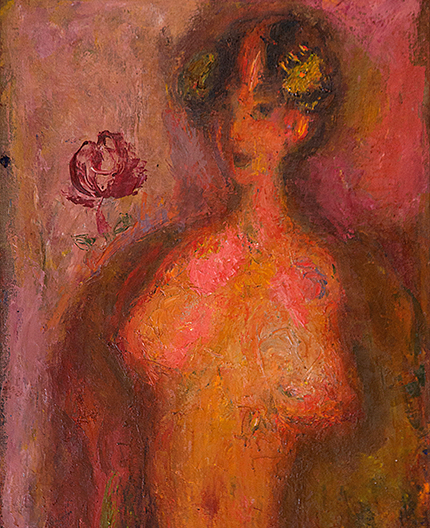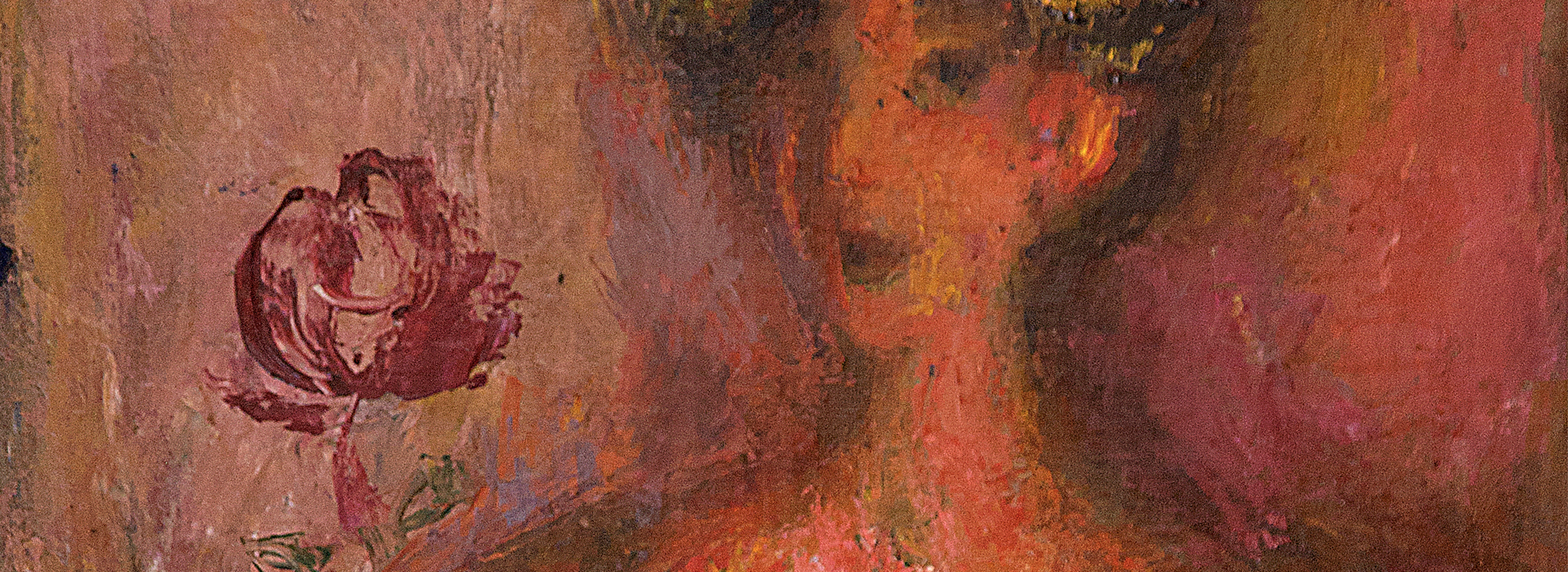
Feel free to add tags, names, dates or anything you are looking for


Esma Oniani's pictorial and graphic images represent the hypostasis of modern Georgian fine art. They go beyond Georgian Soviet painting, and art in general, standing apart as isolated and introspective. Purple paint, serving as the primary tool of self-expression, and the style conditioned by this color, mark a turning point from the ideology of the Soviet Khrushchev Thaw period. At that time, artists primarily focused on Soviet, abstract, historical, and national themes. The generation of the 1950s -1980s, who sought to break free from the constraints of socialist realism, ultimately found themselves at an impasse. Their works often fail to convey the essence and values of the epoch, which is the core purpose of painting - to place the spirit of the time at the forefront of the subjective-objective artistic world. Esma Oniani is among the few who impartially presented this principle, depicting the new Georgian reality, society, and newly viewed cultural paradigms. In this sense, she stands out from the generations of Georgian artists between the Khrushchev Thaw period (1950s) and independent Georgia (1991). It was a harbinger of the beginning of a new artistic "wave," often known as post-Stalinist liberalism. Until the 1990s, each generation of Georgian artists sought to introduce new ideas into the artistic landscape. Esma Oniani began her career in the 1970s, developing her unique style and skills. She can be considered a parallel or marginal figure among the artists of the 1970s, as her strong individualism set her apart from the expressive language of her contemporaries. In the early decades of her career (the 1950s-60s), Oniani was primarily engaged in the search for herself. However, from the 1970s through 1999, she fully matured.

Esma Oniani. Rose in my childhood. Canvas, oil. 1980. This work is part of ATINATI Private Collection
From 1957 to 1963, Esma Oniani studied painting at the Tbilisi Academy of Arts under the guidance of Giorgi Jashi, Sergo Kobuladze, and Ucha Japaridze. From 1966 to 1967, she worked as an art director at Georgian Television, and from 1969 until her death in 1999, she taught at the Academy of Arts. From 1962 onwards, her works were regularly exhibited in union and republic exhibitions in spring and autumn. In addition to her work in painting, graphics, and book illustrations, Oniani also wrote poetry and essays. She is the author of several collections of poetry.
Esma Oniani's work is related to the Renaissance-era concept of "universal man," also known as "polymath." Her view of the universe, search for ideas and the value system can be defined according to several hypostases, beliefs, or creative dimensions. The modeling of the universe is expressed in colors and lines, in critical and poetic linguistic units. Oniani's honesty, melancholic reflection, sense of futility, and profound understanding of universal human problems are equally evident in her essays, poetry, painting, and graphic art. Linguistic and visual categories nourish each other consecutively and symbiotically, creating a multi-layered portrait of the artist through a synergistic blend of colors and words. When we combine poetry, essays, and painting into a single element, we can more clearly perceive the creator's word through color, and color through word. The artist’s mastery, universality, and truth are expressed in an openness to the world, a blend of rational and irrational impulses, creative transparency as a form of self-expression, extreme stylistic and artistic divergence from her contemporaries, and deliberate isolation or self-defense against the Soviet ideology.

Esma Oniani. Presentation of Christ. Canvas, oil. 80x60,5. 1996. Private Collection
Esma Oniani's creative and personal worldview is based on an empirical exploration of pain, sadness, and vanity. In different languages, the word "worldview" presents peculiar linguistic transformations. The Germans, for example, express this idea with the term "Weltschmerz" (world pain), which refers to perceiving the world through spiritual pain. In Oniani’s creative work prevail epistemological beginnings based on cognition and ontological being. Man, as the central value in the world, shapes its cognitive existence. This principle is revealed in the anthropocentrism of Oniani’s poetry and painting, where every color, and everything – painting and word – are grounded in human emotions and expressiveness.

Esma Oniani. Etude. Canvas, oil. 100x60. 1970. Private Collection

Esma Oniani. Astonishment. From the Series "Paradise". Canvas, oil. 120x71. 1989. Private Collection
On canvases where purple and contrasting colors dominate, black contours and impasto often emerge from the background of the figures, emphasizing the significance of a line beyond colors. Portraits, still life, and life scenes are united by several key nuances: nationalism, a reflection of modernity, grotesque elements, and the photofixation of character, moment, and movement. Another subgroup is revealed on the canvases, one depicting hazy and foggy aspects of life, where figures like parents, ancestors, and friends are portrayed in intimate environments and within nature. These works also include still life and landscapes. For the artist, the vague mystery of painting, melancholy, the vanity of life, life’s uniqueness and sadness, and the significance of everyday life scenes, are cherished. In Oniani’s artistic world, two variations of returning to the past or lost time – specifically childhood – are evident: the obscurity conveyed through black and the tonal-chromatic gradation of purple. Da Vinci's sfumato, with its brown gradation, is suitable for this occasion. Esma Oniani, however, developed her own "purple sfumato" - an airy perspective in line and color.

Esma Oniani. Portrait of a Georgian Woman. Canvas, oil. 77х55. 1980. This work is part of ATINATI Private Collection

Esma Oniani. Portrait of Doctor Tatyana Shatilova. Cardboard, oil. 43x24cm. 1991. ATINATI Private Collection.
Between etudes and sketches, it can sometimes be difficult to distinguish which is a graphic work and which is a painting, as they complement each other in plot, emotional tone, and composition. The use of color, figures, objects, spotted color, line flow, lighting and conditionality all show the close association with the styles of the Nabis school, Post-Impressionism, and Intimism. Ephemeral permanence – this oxymoron encapsulates the essence of life, where mutually exclusive concepts like pain and joy intertwine. In her etudes and sketches, the artist melancholically searches for ancestors, objects, relics, personalities, and childhood memories, seeking to restore the old material fabric without which she could not live.

Esma Oniani. Etude. Cardboard, oil. 48x33. 1963. Private Collection
Her graphic series equally reflects Oniani’s skills and artistic vision. Each piece is a distinct accent or frame for the world depicted on the canvases. In her graphic works, in contrast to her paintings, the artist uses more of the French Cartesian rules of rationalism, even though her way of thinking remains subjective. For Oniani, color is the primary element of lighting, and the line is the fundamental element of dynamics. The artistic traditions of the early French modernist school – Matisse, Bonnard, Picasso, Post-Impressionism, Intimism, and the Nabis – coexist harmoniously in her works- works which are written in archaic and contemporary planes. Her realistic and academic graphic works primarily represent an exploration of the early period, and their value lies in the moderate use of classical rules. The portraits, still life, and landscapes are realistic, evoking a sense of photographic accuracy and aesthetics. None of the works in this style reflect Soviet idealization or kitsch elements. Oniani’s series of children's illustrations vividly captures the essence of childhood, marked by melancholy and a longing for lost time. It represents a balance of emotional expression in the fine arts: adults capture emotions metaphorically, while children convey them through their direct perception. Staged like a great director's mise-en-scène, animals, objects, spaces, people, and everyday scenes illustrate the lost and found time of childhood.

Esma Oniani. Street in Yurmala. Cardboard, oil. 80x49. 1988. Private Collection

Esma Oniani. Street in Riga. Cardboard, oil. 78.5x49. 1988. Private Collection
Esma Oniani's use of color, much like language, is a quest for lost time and a means of self-discovery. Marcel Proust's extensive novel embodies the sense of longing and the struggle for freedom that characterizes many artists of the twentieth century. Proust is like the mythological Symplegades of truth and false. Indeed, the artist continually references Proust's creative and personal phenomenon in her essays, frequently thinking about herself, using Proust as a source of inspiration in her texts. Oniani’s work can be described by the word "real" - she created uncompromisingly “real” pieces. Her artistic world is defined by a longing for lost time, driven by the desire to discover something new, to be free, and to liberate others.
Why was the artist looking for lost time? To create non-Soviet Georgian art that was real and universal. She was one of the first artists to replace ideology and regime with representations of free people. Unlike her contemporaries, she rejected fabricated, imagined, or "dictated" narratives, choosing instead to engage with the reality of the decades in which she had to live. Each scene of everyday life was greater than the art constrained by political power.

Esma Oniani. Tbilisi View. Cardboard, oil. 49x49. 1960. Private Collection
P.S.
Esma Oniani was an artist and a person the Soviet regime could not affect. In Svaneti, some families keep ancestral relics, impervious not only to regimes but even to the passage of centuries. Oniani protected her inner purity and sincerity like a family heirloom, and this became the cornerstone of her creative work.